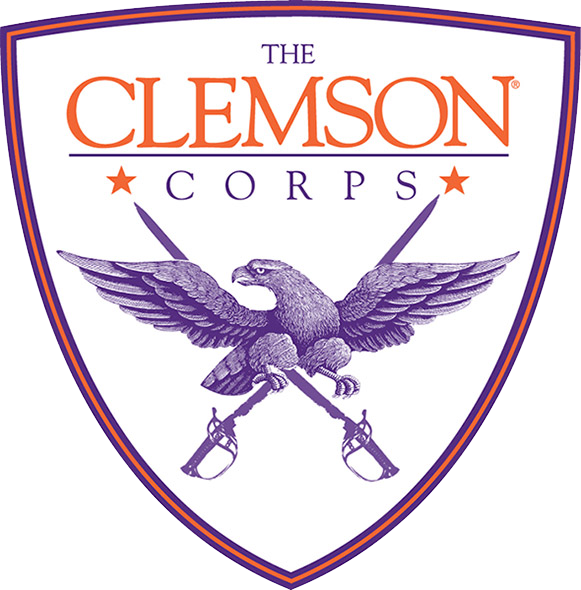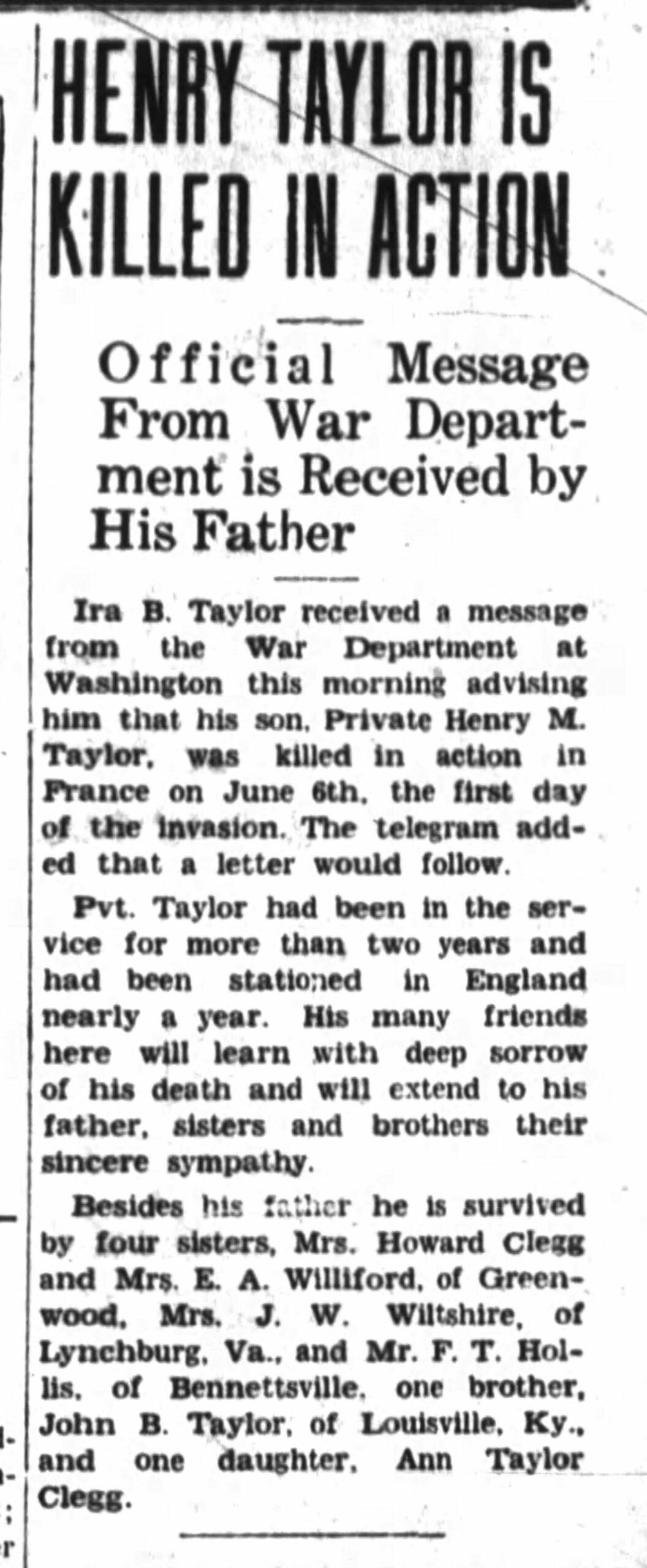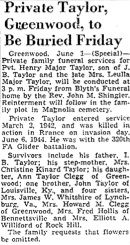
Henry Major Taylor

1938
Textiles
Attended Clemson College during the 1934-1935 school year.
Greenwood, South Carolina
Army, Private
320th Field Artillery Glider Battalion, 82nd Airborne Division
Purple Heart
Sep 27, 1916
Jun 6, 1944
Killed in Action on the first day of the invasion at Normandy (D-Day).
Magnolia Cemetery, Greenwood, SC
SW
Additional Information
The 320th Glider Field Artillery Battalion arrived into battle by glider and parachutes on 6 June 1944. Poor visibility and low ceiling made air navigation extremely difficult. As a result, gliders were badly scattered for miles along the drop zone. By 0930 the following day, only two howitzers were in action – one firing north and one firing south. Extract from an 82nd ABD website
Extract From – 82D AIRBORNE DIVISION WAR MEMORIAL MUSEUM Click HERE to read the entire articleThe 82d Infantry Division was called to active duty on March 25, 1942, at Camp Claiborne, Louisiana, under the command of Major General Omar N. Bradley. On August 15, 1942, the division took wings as the 82d Airborne-becoming the U.S. Army’s first airborne division-now commanded by Major General Mathew B. Ridgway. At the same time, half of 82d Soldiers were used in the formation of a second airborne division-the “Screaming Eagles” of the 101st Airborne Division.
In October, the 82d was sent to Fort Bragg, North Carolina, to conduct airborne training. By the time they went overseas, the 82d would consist of 325th Glider Infantry Regiment and the 504th and 505th Parachute Infantry Regiments. In the spring of 1943, the 82d All Americans became the first airborne division sent overseas landing in Casablanca, North Africa, on May 10, 1943. From there, they moved by rail to Oujda and then by truck to Kairouan, Tunisia. That would be their departure point for the Division’s first combat drop-the invasion of Sicily.
By September 13, 1943, General Mark Clark’s Fifth Army had held tenaciously to the Salerno beachhead for four days but needed quick assistance. He sent a message to Major General Ridgway requesting a drop that night. A plan was immediately set for the 504th Parachute Infantry Regiment to jump several miles from Clark’s embattled troops, then be driven in trucks to the front lines. It went just as smoothly the next night, when Colonel Gavin and 1,900 of his 505th All Americans, including 1LT Ivy K. Connell, Clemson Class of 1943, arrived. A day later, 14 September the beachhead was declared secure-a feat that could not have been attained without the 82d’s assistance. Lieutenant Connell, was killed in action in Italy on October 6._______________ ++++ _______________
With Salerno secure, General Ridgway led his division, with other 5th Army units, on the key seaport of Naples. There, the 82d troopers enjoyed the experience of liberating that famous city. In November, after sharp fight in mountains around Naples, the 82d withdrew to England to prepare for the invasion of France. General Clark kept the 504th PIR in Italy where they fought at Anzio, returning to the 82d in April 1944. It was at Anzio that the 504th earned its famous nickname “Devils in Baggy Pants.”
With Italy in good hands, Allied eyes focused on France. Operation “Overlord,” the invasion of Normandy, would be the greatest military operation in history. The massive plans for D-Day included Operation “Neptune,” an all-important airborne phase of Overlord. Ridgway’s All Americans would play an integral part in Neptune. Joined by the 507th and the 508th Parachute Infantry Regiments, the 82d was prepared to assault Normandy with 12,000 Parachute and Glider troops. Their mission: Destroy vital Germany supply bridges and capture causeways leading inland across the flooded areas behind the Normandy beaches where seaborne forces would land to gain control of roads and communications.
It was in this operation that three members of Clemson participated and were casualties. They were PVT Henry M. Taylor HQ Battery 320th Glider Field Artillery (GFA), 1LT Thomas E. Goodson G Company 401st Glider Infantry Regiment (GIR). 1LT Goodson was also the Company Executive Officer. The 401st GIR was part of the 3d BN 325 GIR. It would not be renamed as 3/325th GIR until later. And 1LT William S. Gaillard I Company 505th Parachute Infantry Regiment (PIR). He was the 2d Platoon Leader.
The first planes took off from their airfields in England at 11:15 PM on 5 June 1944. The flight over the English Channel was in good formation and without incident, but between the west coast and the drop zones a heavy fog bank tended to break up the formation of the planes. Flak and some enemy night fighter activity caused some of the troop carrier planes to take evasive action and by the time they reached the drop zone many of the planes were scattered. They were also flying at excessive speeds and at altitudes that were not ideal for jumping.
The first element of 2d Battalion 505th PIR dropped at 0151 hours and the entire regiment landed by 0220 hours most troops landed on or near the drop zone, some were scattered over the countryside. Assembly was quick and battalion moved off to their objectives. 3d Battalion entered and secured Ste Mere Eglise at 0400 hours. The American flag that flew in Naples during the time the 82d was performing occupation duty there flew over the tallest building in Ste Mere Eglise. This made Ste Mere Eglise the first town to be liberated by the Allies. At 0600 hours the 2d Battalion moved north of Ste Mere Eglise to assist 3d Battalion in holding the town. 1st Battalion moved to the bridge over the Merderet River at La Fiere at 0630. By 0830 1st Battalion held the eastern end of the bridge against heavy enemy fire from western approach.
At 1305 HQ and HQ BTRY 319th GFA and 320th GFA glided into Normandy encountering severe small arms and mortar fire. Reorganization commenced immediately however it was slowed down due to enemy fire. It is a good possibility that PVT Henry M. Taylor was one of those killed when the gliders landed. He was killed on the first day of the invasion. At D+1glider elements began to land at 0700. The 325th GIR along with the 401st GIR gliders landed about 2,500 yards south east of Ste Mere Eglise. Many crash landed and casualties were high. By 1015 hours all battalions were in operation. 3d Battalion moved toward Carquebut at 1415 and reached Le Port without opposition. The remainder of the regiment moved into an assembly area north east of Chef du Pont. At 1600 2d Battalion moved to an assembly area east of La Fiere they would later be attached to the 505th PIR at 2100 hours. 1st and 3d BNs were ordered to move into an outpost in the regimental assembly area. 2d and 3d BNs 505th PIR continued to hold Ste Mere Eglise from attacks from the north and south. The 2d and 3d BNs prepared to attack north toward Neuville Au Plain in conjunction with the 4th Infantry Division drive on the right. The 2d BN 325th GIR was attached at 2100 to assist in the attack. The 320th GFA was place in direct support of the 505th PIR. After salvaging two 105mm M3 Howitzers and taking over the 75mm pack howitzer of the 456thParachute Field Artillery (PFAB) with 505th. The 320th went into position 400 yards west of Ste Mere Eglise and the first round was fired at 0911.
The airborne troops continued their ferocious fight as infantrymen for 33 days after landing at Normandy. When relieved to go to England, tallies showed nearly half of the 82d’s Soldiers had been wounded, captured or killed. But they had cost the Germans many more men and had destroyed 62 enemy tanks and 44 anti-tank guns and artillery pieces. Most importantly, they had choked off reinforcements for the Axis forces defending the French coast preventing some 35,000 to 40,000 enemy troops from rushing to the sea where they were needed. After the Allies victory on May 7, 1945 V.E. Day with Germany’s unconditional surrender, and in July, the 82d was sent to patrol the American sector of Berlin. There, the division got its nickname of “American’s Guard of Honor” when General George Patton told them, “In all my years in the Army, and of all the honor guards I have ever seen, the 82d honor guard is undoubtedly the best.” The 82d wound up being one of the most highly decorated U.S. Army divisions in the war. The 82d paratroopers earned three Medals of Honor, 79 Distinguished Services Crosses, 894 Silver Stars, 2,478 Bronze Stars, numerous foreign decorations.
After three years overseas and 442 days in combat, the most by any airborne division the 82d returned to the United States January 3, 1946, to a roaring reception in New York City. But there was a somber side to the war’s conclusion: The 82d’s casualty count showed 3,228 dead, 106 missing and 12604 wounded. While several Army airborne units were inactivated after the war, the highly decorated 82d returned to Fort Bragg to vigorously and pride fully maintain the high state of readiness it showed during its long service in World War II.Airborne All The Way
Rafael Alvarez Museum Technician 82d Airborne Division Museum



